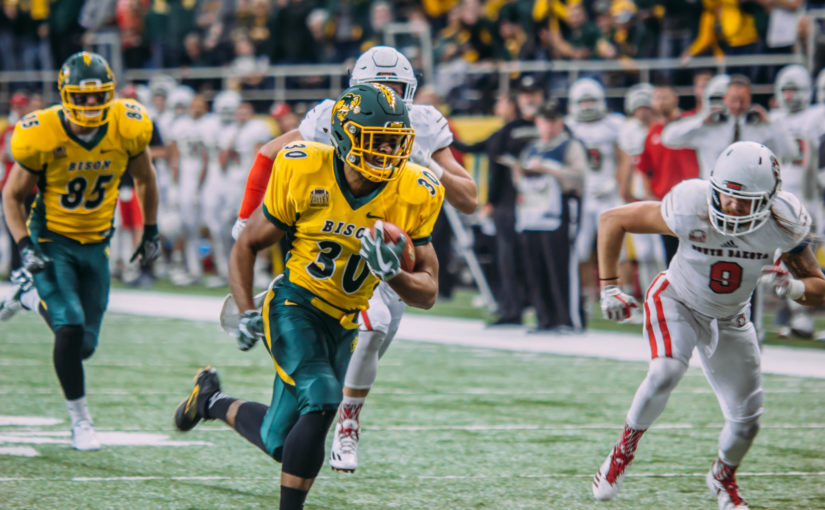The Bison football team kicks off its FCS title defense this upcoming Saturday, hosting Cal Poly at 2:30 p.m. in the Fargodome. Even with the season just days away, so much is still unknown for North Dakota State. As the Herd progresses through the season, keep track on these storylines.
What is the ceiling for the secondary?
The Bison’s back four have the chance to be one of the top units in the FCS. Returning starters Jalen Allison, captain Robbie Grimsley and Jaylaan Wimbush will be the staples of the secondary. Wimbush moves from the No. 2 cornerback to free safety, where he’ll also split time with an experienced James Hendricks.
Wimbush’s move is due to both Chris Board’s graduation and Marquise Bridges’ emergence as a reliable cover corner. Bridges started the national championship game in place of Allison, who was injured in the semifinal against Sam Houston State. Bridges’ baptism by fire allows Wimbush to move to the back where his downhill speed can be best utilized. Josh Hayes also filled in for Wimbush in Frisco, proving himself to be a capable substitute in case of injury.
In 2017, NDSU ranked second in passing touchdowns allowed with seven and third in passing yards allowed at 147.9 yards per game. With Allison, Grimsley, Hendricks and Wimbush all returning, the talent is in place once again to rank at the top on a national level.
How will four running backs be used on a regular basis?
Any FCS coach looking for a bell cow running back is envious of Bison head coach Chris Klieman’s situation. In Bruce Anderson and Lance Dunn, Klieman has two seniors capable of carrying a three-down workload. Add to that duo Ty Brooks and Seth Wilson and the pieces are in place to form an electrifying quartet.
Coaches across all levels of sports will never complain about having too many talented options for one position. However, best deploying what is effectively a group of four feature running backs will be Klieman’s task.
Anderson and Dunn are capable as three-down backs, but barring injury it’s unlikely either will be depended upon to fill that role. On second-and-short or other opportunities for big plays, Brooks will be the option. Having averaged 9.2 yards per carry, Brooks provides endless big-play potential, leading Klieman to refer to him as the “most electric running back in the FCS.”
Wilson demonstrated excellent hands as a receiving option last year, making him a go-to for passing down situations. Though he only tallied six receptions, two found the end zone, which augments an already multifaceted group.
Who emerges as Easton Stick’s top target?
Losing steady wideout R.J. Urzendowski to graduation was going to hurt. Add to that the loss of the top two tight ends Jeff Illies and Connor Wentz makes for an even more troublesome situation.
Darrius Shepherd returns as the clear-cut top option, but the senior didn’t catch a touchdown until the national championship game. Dimitri Williams, a threatening option on the jet sweep, is transitioning to running back, which he was originally recruited as.
Shepherd will be relied upon heavily to catch passes from the outside. Behind the senior, the wide receiver group is scant on meaningful game experience. Dallas Freeman and Desmond Cain enter the season behind Shepherd. The two combined for 11 receptions and one touchdown a season ago, but both have breakout potential.
Stick may need to rely upon his group of tight ends at the beginning of the season. Nate Jensen and Ben Ellefson went for 244 yards in 2017. While that alone isn’t an impressive mark, Ellefson caught three scores, and both are seasoned in NDSU’s offense. The Bison will have to hope their tight ends, in addition to Shepherd, will buy time for their other receivers to coalesce.
What weaknesses does NDSU have?
All aspects of the special teams play are in need of improvement, an issue Klieman has sought to resolve through more drills and enhanced offseason competition.
What cannot be resolved through more reps is the loss of key personnel. Punter and holder Jackson Koonce and All-American long snapper James Fisher both graduated. Filling the punting and holding duties will be Garret Wegner. The sophomore from Lodi, Wisconsin played in six games, but only averaged 32.7 yards per punt.
Ross Kennelly, who has no game experience, will take Fisher’s place as the long snapper. The lack of game experience is concerning for a unit which finished 81st in kick return defense and 114th in punt return defense in 2017. Incorporating inexperienced players into what was already a struggling unit could prove to be the difference maker in close games.
On each side of the ball, who is in line for a breakout season?
In 2017, Dan Marlette capitalized on his opportunity to fill in for the injured Nick DeLuca at middle linebacker. Incidentally, in the same game DeLuca returned from injury, Marlette suffered an injury of his own, tearing his ACL on a kickoff.
The Sioux Falls, South Dakota native proved to be a force in four games, two of which he started, forcing two fumbles and bagging 10 tackles. Fully recovered from injury, Marlette is now the starting middle linebacker and figures to return to the form he reached prior to injury.
Left tackle Dillon Radunz also suffered a season-ending ACL tear in 2017, coming against Mississippi Valley State in the Bison’s first game. At 6-foot-6-inches and 299 pounds, the sophomore possesses a huge frame and is a player Klieman and offensive line coach Conor Riley have been excited about since he first set foot on campus.
Like Marlette, Radunz is fully healed and slots into a starting role immediately. His return allows Colin Connor to move from left tackle to left guard, shoring up the interior. Radunz shoulders a great deal of responsibility, but having three seniors in the middle of the line gives the Becker, Minnesota product room to develop.
